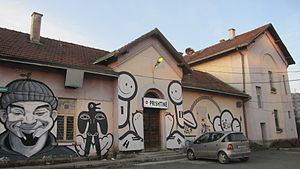Pristina railway station
|
Pristina
Prishtinë Priština / Приштина |
|
|---|---|

The station frontage in 2009
|
|
| Location | Tirana Boulevard Pristina Kosovo |
| Coordinates | 42°39′32″N 21°09′04″E / 42.658934°N 21.151067°ECoordinates: 42°39′32″N 21°09′04″E / 42.658934°N 21.151067°E |
| Platforms | 2 |
| Tracks | 2 |
| History | |
| Opened | 1936 |
Pristina railway station (Albanian: Stacioni i trenit në Prishtinë; Serbian: Prištinska železnička stanica / Приштинска железничка станица) is the central railway station in the city of Pristina, the capital of Kosovo. It opened on Tirana Boulevard (formerly 'Omladinskih Brigada') in 1936, having been constructed by a French/British company. Trains calling at the station are operated by Trainkos sh.a.
The line on which the station sits is single-track, laid to standard gauge, but there is a loop at the station, allowing trains to pass there, with a second, parallel, loop lying out-of-use as of October 2016.
A daily international train runs between Pristina and Skopje, in Macedonia.
Pristina is also served by the larger Kosovo Polje railway station at nearby Kosovo Polje.
During the era when Kosovo was part of the Socialist Federal Republic of Yugoslavia, the country's leader Marshall Tito occasionally visited Pristina, arriving on his personal Blue Train.
During the 1999 Kosovo War, Serbian and Yugoslav regular forces, in conjunction with paramilitaries, conducted large-scale ethnic cleansing of ethnic Albanian inhabitants of Pristina through the station. Many of those expelled were directed onto trains apparently brought there for the express purpose of deporting them to the border of the Republic of Macedonia, where they were forced into exile.
On, or about, 1 April 1999, Serbian police went to the homes of Kosovo Albanians in the city of Pristina/Prishtinë and forced the residents to leave in a matter of minutes. During the course of Operation Horseshoe, a number of people were killed. Many of those forced from their homes went directly to the train station, while others sought shelter in nearby neighbourhoods. Hundreds of ethnic Albanians, guided by Serb police at all the intersections, gathered at the train station and then were loaded onto overcrowded trains or buses after a long wait where no food or water was provided. Those on the trains went as far as Đeneral Janković, a village near the Macedonian border. During the train ride many people had their identification papers taken from them.
...
Wikipedia
